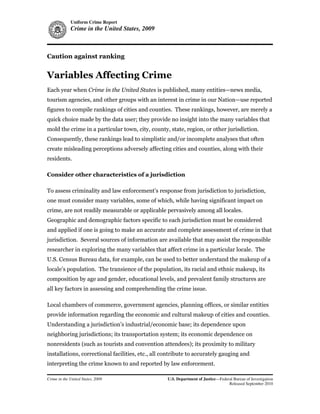
Ucr variablesaffectingcrime
- 1. Uniform Crime Report Crime in the United States, 2009 Caution against ranking Variables Affecting Crime Each year when Crime in the United States is published, many entities—news media, tourism agencies, and other groups with an interest in crime in our Nation—use reported figures to compile rankings of cities and counties. These rankings, however, are merely a quick choice made by the data user; they provide no insight into the many variables that mold the crime in a particular town, city, county, state, region, or other jurisdiction. Consequently, these rankings lead to simplistic and/or incomplete analyses that often create misleading perceptions adversely affecting cities and counties, along with their residents. Consider other characteristics of a jurisdiction To assess criminality and law enforcement’s response from jurisdiction to jurisdiction, one must consider many variables, some of which, while having significant impact on crime, are not readily measurable or applicable pervasively among all locales. Geographic and demographic factors specific to each jurisdiction must be considered and applied if one is going to make an accurate and complete assessment of crime in that jurisdiction. Several sources of information are available that may assist the responsible researcher in exploring the many variables that affect crime in a particular locale. The U.S. Census Bureau data, for example, can be used to better understand the makeup of a locale’s population. The transience of the population, its racial and ethnic makeup, its composition by age and gender, educational levels, and prevalent family structures are all key factors in assessing and comprehending the crime issue. Local chambers of commerce, government agencies, planning offices, or similar entities provide information regarding the economic and cultural makeup of cities and counties. Understanding a jurisdiction’s industrial/economic base; its dependence upon neighboring jurisdictions; its transportation system; its economic dependence on nonresidents (such as tourists and convention attendees); its proximity to military installations, correctional facilities, etc., all contribute to accurately gauging and interpreting the crime known to and reported by law enforcement. Crime in the United States, 2009 U.S. Department of Justice—Federal Bureau of Investigation Released September 2010
- 2. The strength (personnel and other resources) and the aggressiveness of a jurisdiction’s law enforcement agency are also key factors in understanding the nature and extent of crime occurring in that area. Although information pertaining to the number of sworn and civilian employees can be found in this publication, it cannot be used alone as an assessment of the emphasis that a community places on enforcing the law. For example, one city may report more crime than a comparable one, not because there is more crime, but rather because its law enforcement agency, through proactive efforts, identifies more offenses. Attitudes of the citizens toward crime and their crime reporting practices, especially concerning minor offenses, also have an impact on the volume of crimes known to police. Make valid assessments of crime It is incumbent upon all data users to become as well educated as possible about how to understand and quantify the nature and extent of crime in the United States and in any of the nearly 18,000 jurisdictions represented by law enforcement contributors to the Uniform Crime Reporting (UCR) Program. Valid assessments are possible only with careful study and analysis of the various unique conditions affecting each local law enforcement jurisdiction. Historically, the causes and origins of crime have been the subjects of investigation by many disciplines. Some factors that are known to affect the volume and type of crime occurring from place to place are: • Population density and degree of urbanization. • Variations in composition of the population, particularly youth concentration. • Stability of the population with respect to residents’ mobility, commuting patterns, and transient factors. • Modes of transportation and highway system. • Economic conditions, including median income, poverty level, and job availability. • Cultural factors and educational, recreational, and religious characteristics. Crime in the United States, 2009 U.S. Department of Justice—Federal Bureau of Investigation Released September 2010 2
- 3. • Family conditions with respect to divorce and family cohesiveness. • Climate. • Effective strength of law enforcement agencies. • Administrative and investigative emphases of law enforcement. • Policies of other components of the criminal justice system (i.e., prosecutorial, judicial, correctional, and probational). • Citizens’ attitudes toward crime. • Crime reporting practices of the citizenry. Crime in the United States provides a nationwide view of crime based on statistics contributed by local, state, tribal, and federal law enforcement agencies. Population size and student enrollment are the only correlates of crime presented in this publication. Although many of the listed factors equally affect the crime of a particular area, the UCR Program makes no attempt to relate them to the data presented. The data user is, therefore, cautioned against comparing statistical data of individual reporting units from cities, counties, metropolitan areas, states, or colleges or universities solely on the basis of their population coverage or student enrollment. Until data users examine all the variables that affect crime in a town, city, county, state, region, or other jurisdiction, they can make no meaningful comparisons. Crime in the United States, 2009 U.S. Department of Justice—Federal Bureau of Investigation Released September 2010 3